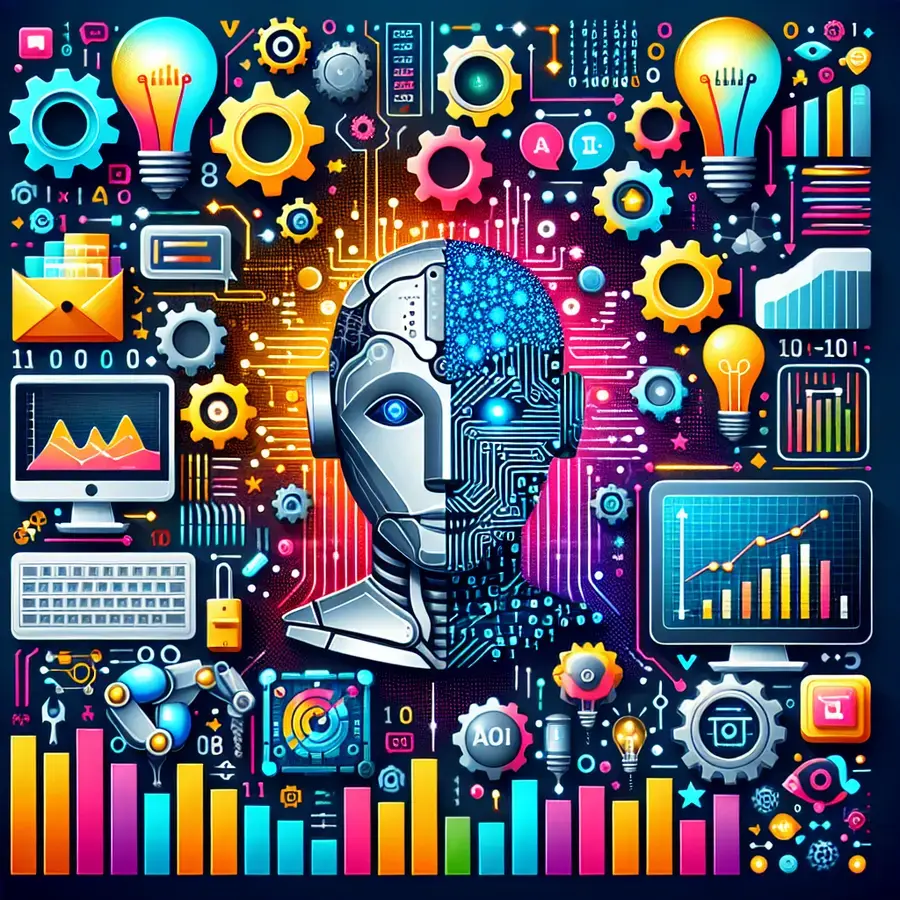Unlocking the Power of AI: Boosting Business Productivity

In today’s fast-paced business landscape, staying ahead of the curve is crucial. Did you know that companies that adopt AI technology see an average increase of 30-40% in productivity within the first year? As a seasoned expert in the field of business technology, with years of experience in helping organizations harness the power of AI, I’m excited to share with you the most effective AI tools to take your business to the next level.
As businesses continue to navigate the complexities of a rapidly changing world, leveraging AI is no longer a luxury, but a necessity. In this article, we’ll explore the best AI tools designed to streamline processes, enhance collaboration, and drive growth. By the end of this article, you’ll be equipped with the knowledge to make informed decisions and propel your business forward.
📚 Table of Contents
- Maximizing Business Efficiency with AI
- How to Choose the Right AI Tool for Your Business Needs
- Top AI Productivity Tools for Team Collaboration
- AI-Powered Task Automation: A Step-by-Step Guide
- Comparing the Best AI Tools for Business: Features and Pricing
- The Impact of AI on Business Productivity: Real-World Results
- Streamlining Workflows with AI-Driven Solutions
- Best Practices for Implementing AI Tools in Your Organization
- AI Tools for Enhancing Employee Productivity and Engagement
- Evaluating the ROI of AI Investments in Business Productivity
- Leveraging AI for Data-Driven Decision Making
- Overcoming Common Challenges in AI Adoption for Business Productivity
Maximizing Business Efficiency with AI
To maximize business efficiency with AI, it’s essential to identify areas where automation can have the most significant impact. Streamlining repetitive tasks is a great starting point, as it frees up staff to focus on higher-value tasks. By automating routine processes, businesses can reduce the likelihood of human error and increase productivity.
AI-powered tools can also help businesses optimize their workflows by analyzing data and identifying bottlenecks. Implementing AI-driven workflow optimization can lead to significant improvements in efficiency and productivity. This can be achieved through the use of AI-powered business process management tools.
Some key strategies for maximizing business efficiency with AI include:
- Implementing AI-powered chatbots to handle customer inquiries and support requests
- Using machine learning algorithms to analyze data and identify trends
- Automating tasks such as data entry and bookkeeping
By leveraging these strategies, businesses can significantly improve their overall efficiency and stay ahead of the competition. As AI technology continues to evolve, it’s likely that we’ll see even more innovative applications of AI in the business world.
How to Choose the Right AI Tool for Your Business Needs
Choosing the right AI tool for your business needs can be a daunting task, given the numerous options available in the market.
Start by identifying your business goals and the specific tasks you want to automate or enhance with AI, such as customer service, data analysis, or content creation.
Consider the type of data you will be working with and the level of integration required with your existing systems and infrastructure.
- Assess the tool’s compatibility with your data formats and sources.
- Evaluate the tool’s scalability and flexibility to adapt to your growing business needs.
- Check the vendor’s support and training options to ensure a smooth onboarding process.
It’s also crucial to consider the tool’s user interface and user experience, as it will impact adoption rates among your team members.
Read reviews, ask for referrals, and request demos to get a firsthand experience of the tool’s capabilities and limitations.
Ultimately, the right AI tool should align with your business objectives, be easy to use, and provide a strong return on investment.
Top AI Productivity Tools for Team Collaboration
Effective team collaboration is crucial for business productivity, and AI tools can significantly enhance this aspect. AI-powered collaboration tools can automate routine tasks, facilitate communication, and provide valuable insights. By leveraging these tools, teams can work more efficiently and achieve better outcomes.
Some top AI productivity tools for team collaboration include project management platforms that utilize AI to predict project timelines and identify potential roadblocks. Tools like Trello and Asana integrate AI to automate task assignments and track progress. These platforms enable teams to stay organized and focused on their goals.
- Slack with AI-powered chatbots for streamlined communication and task management.
- Microsoft Teams with AI-driven meeting insights and transcription services.
- Notion with AI-enhanced note-taking and knowledge management capabilities.
When selecting an AI productivity tool for team collaboration, consider the specific needs of your team. Assess the tool’s ability to integrate with your existing workflows and its capacity for customization. This ensures a seamless adoption process and maximizes the tool’s effectiveness.
To get the most out of AI productivity tools, it’s essential to provide training and support to your team. Encourage experimentation and feedback to help your team adapt to the new tools and workflows. By doing so, you can unlock the full potential of AI-driven collaboration and drive business success.
AI-Powered Task Automation: A Step-by-Step Guide
AI-powered task automation is revolutionizing the way businesses operate by streamlining processes and freeing up valuable time for strategic decision-making. By automating repetitive and mundane tasks, organizations can significantly improve productivity and reduce the likelihood of human error. This enables teams to focus on high-value tasks that drive business growth.
The first step in implementing AI-powered task automation is to identify tasks that are ripe for automation. Look for processes that are repetitive, time-consuming, and prone to errors, such as data entry, document processing, or customer service inquiries. These tasks are ideal candidates for automation.
Once you’ve identified the tasks to automate, select the right AI tool for the job. Consider factors such as the tool’s ease of use, integration with existing systems, and scalability. Popular AI-powered automation tools include robotic process automation (RPA) software and workflow automation platforms.
- Define the automation workflow by mapping out the steps involved in the task and identifying any decision points or exceptions.
- Configure the AI tool to perform the automated tasks, using techniques such as machine learning or rules-based processing.
- Test and refine the automation workflow to ensure it is working as intended and make any necessary adjustments.
By following these steps and leveraging the power of AI-powered task automation, businesses can achieve significant productivity gains and improve overall efficiency. This enables organizations to stay competitive in a rapidly changing business landscape and drive long-term success.
Comparing the Best AI Tools for Business: Features and Pricing
When evaluating the best AI tools for business, it’s essential to consider both features and pricing to ensure they align with your organization’s needs and budget.
Key features to look for include automation capabilities, data analysis, and integration with existing software. Some AI tools specialize in specific areas, such as customer service or project management, while others offer a broader range of functionalities.
Pricing models vary significantly across AI tools, with some offering subscription-based services, others charging per user, and a few providing custom pricing for enterprises.
- Grammarly Business: Offers advanced writing tools with a focus on grammar, clarity, and style, starting at $12.50 per user/month.
- Trello with Power-Ups: Enhances project management with AI-driven features like automated task assignment and due dates, priced at $12.50 per user/month.
- Zoom with AI Companion: Provides AI-enhanced video conferencing features, including meeting summaries and transcription, starting at $13.33 per user/month.
When comparing these tools, consider the total cost of ownership, including any additional fees for support, training, or customization.
It’s also crucial to assess the return on investment (ROI) by evaluating how each tool can improve productivity, reduce costs, or enhance customer satisfaction.
The Impact of AI on Business Productivity: Real-World Results
The integration of AI into business operations has led to significant improvements in productivity, with companies experiencing up to 40% increase in efficiency. This is largely due to AI’s ability to automate routine and repetitive tasks, freeing up staff to focus on more strategic and creative work.
One of the key areas where AI has made a substantial impact is in task management and organization. AI-powered tools can analyze workflows, identify bottlenecks, and optimize task allocation to maximize team productivity.
AI-driven analytics is another area where businesses have seen significant benefits. By analyzing large datasets, AI can provide actionable insights that inform business decisions, reduce uncertainty, and drive growth.
- Automating customer service with AI-powered chatbots, resulting in 24/7 support and reduced response times.
- Using AI-driven predictive maintenance to minimize downtime and reduce maintenance costs.
- Implementing AI-based time management tools to streamline workflows and enhance employee productivity.
By leveraging these AI-powered solutions, businesses can achieve sustainable productivity gains and stay ahead of the competition.
Streamlining Workflows with AI-Driven Solutions
Implementing AI-driven solutions can significantly streamline workflows, allowing businesses to automate repetitive tasks and focus on high-priority projects.
Automating routine tasks is one of the primary benefits of AI-driven solutions, freeing up staff to concentrate on complex and creative tasks that require human expertise.
AI-powered tools can analyze workflows and identify areas where automation can have the greatest impact, such as data entry, document processing, and customer service.
- AI-driven chatbots can handle customer inquiries, providing 24/7 support and reducing the workload of human customer support agents.
- Machine learning algorithms can analyze data and identify patterns, enabling businesses to make data-driven decisions and optimize their operations.
- AI-powered workflow management tools can predict potential bottlenecks and suggest optimizations, ensuring that projects are completed on time and within budget.
By leveraging AI-driven solutions, businesses can improve productivity and efficiency, reduce costs, and enhance overall competitiveness in their respective markets.
To get the most out of AI-driven solutions, businesses should carefully evaluate their workflow needs and select tools that are tailored to their specific requirements.
Best Practices for Implementing AI Tools in Your Organization
Implementing AI tools in your organization requires careful planning and execution to maximize their potential benefits. Start by identifying specific business problems or areas where AI can add significant value. This could be automating repetitive tasks, enhancing customer service, or improving data analysis.
Once you’ve identified the areas for AI implementation, it’s crucial to assess your organization’s readiness for AI adoption. This includes evaluating your data quality, IT infrastructure, and the skills of your workforce.
A key step in successful AI tool implementation is to select tools that integrate well with your existing systems and workflows. This ensures a seamless transition and minimizes disruptions to your operations.
- Consider the scalability of the AI tool to ensure it can grow with your organization.
- Evaluate the vendor’s support and training offerings to ensure your team can effectively use the tool.
- Assess the tool’s compliance with relevant data protection and privacy regulations.
After selecting an appropriate AI tool, develop a comprehensive implementation plan that includes timelines, budgets, and resource allocation. This plan should also outline how you will measure the tool’s effectiveness and ROI.
Finally, foster a culture that embraces innovation and is open to the changes AI tools bring. This includes providing necessary training and encouraging feedback from employees who will be using the AI tools.
AI Tools for Enhancing Employee Productivity and Engagement
AI tools can significantly enhance employee productivity and engagement by automating routine tasks and providing personalized support. Automating mundane tasks allows employees to focus on high-value tasks that require creativity and problem-solving skills. This leads to increased job satisfaction and reduced turnover rates.
AI-powered virtual assistants can help employees manage their workload more efficiently by providing real-time task prioritization and reminders. These virtual assistants can also help employees stay organized and on track, reducing the likelihood of missed deadlines and forgotten tasks.
Some AI tools offer sentiment analysis and feedback mechanisms that help managers gauge employee satisfaction and identify areas for improvement. This enables organizations to take proactive measures to address employee concerns and create a more positive work environment.
- AI-powered chatbots can provide employees with instant support and answers to frequently asked questions, reducing the need for human intervention.
- AI-driven analytics tools can help organizations identify productivity bottlenecks and optimize workflows to improve overall efficiency.
- AI-based training platforms can offer employees personalized learning and development opportunities, enhancing their skills and knowledge.
By leveraging these AI tools, organizations can create a more productive, engaged, and motivated workforce. Regular evaluation and implementation of AI solutions can help businesses stay ahead of the curve and achieve their goals.
Evaluating the ROI of AI Investments in Business Productivity
When considering the adoption of AI tools for business productivity, one crucial factor to evaluate is the return on investment (ROI). A well-planned AI investment can significantly boost productivity and efficiency, leading to substantial cost savings. This, in turn, can have a positive impact on the bottom line.
To accurately assess the ROI of AI investments, businesses must first identify the specific areas where AI can have the most impact. Common areas include automating repetitive tasks, enhancing customer service, and improving data analysis. By focusing on these key areas, businesses can maximize the benefits of their AI investments.
The next step is to establish clear metrics for measuring the success of AI implementations. Key performance indicators (KPIs) such as productivity gains, cost reductions, and revenue increases can be used to evaluate the effectiveness of AI tools. By tracking these metrics, businesses can determine whether their AI investments are yielding the desired results.
Some key considerations when evaluating the ROI of AI investments include:
- The initial cost of implementing AI solutions, including hardware, software, and training expenses.
- Ongoing maintenance and support costs, which can impact the overall ROI.
- The potential for AI to drive long-term revenue growth through improved customer engagement and enhanced competitiveness.
Ultimately, the ROI of AI investments in business productivity will depend on a variety of factors, including the specific tools and technologies adopted, the effectiveness of implementation, and the ability to measure and track key metrics. By carefully evaluating these factors and establishing a clear plan for measuring success, businesses can maximize the benefits of their AI investments and drive long-term growth.
Leveraging AI for Data-Driven Decision Making
Leveraging AI for data-driven decision making is a game-changer for businesses looking to boost productivity. By harnessing the power of artificial intelligence, organizations can analyze vast amounts of data to gain valuable insights. This enables businesses to make informed decisions, rather than relying on intuition or guesswork.
One of the key benefits of using AI for data-driven decision making is its ability to identify patterns and trends that may have gone unnoticed by human analysts. AI-powered tools can process large datasets quickly and accurately, freeing up staff to focus on higher-level tasks. This not only improves productivity but also reduces the risk of human error.
To get the most out of AI-driven data analysis, businesses should consider the following best practices:
- Clearly define the goals and objectives of the analysis to ensure the AI tool is focused on the right tasks.
- Ensure the quality and integrity of the data being analyzed to prevent biased or inaccurate results.
- Regularly review and update the AI tool’s configuration to adapt to changing business needs.
By following these best practices and leveraging AI for data-driven decision making, businesses can unlock new opportunities for growth and improvement. The right AI tool can help organizations stay ahead of the competition and achieve their goals more efficiently.
Overcoming Common Challenges in AI Adoption for Business Productivity
One of the primary challenges businesses face when adopting AI for productivity is the lack of clear goals and objectives. Defining what you want to achieve with AI is crucial to ensure that the technology is aligned with your business needs. This involves identifying specific pain points and areas where AI can add value.
Another significant hurdle is the quality and availability of data. AI algorithms require high-quality data to learn and make accurate predictions. Ensuring that your data is clean, organized, and accessible is vital to the success of your AI initiatives.
Resistance to change is also a common obstacle to AI adoption. Employees may be hesitant to adopt new technologies, fearing that they will be replaced or that the technology will be too complex to use. Effective change management and training programs can help alleviate these concerns and ensure a smooth transition.
To overcome these challenges, businesses can take several steps, including:
- Conducting thorough needs assessments to identify areas where AI can add value
- Developing clear data management strategies to ensure high-quality data
- Providing comprehensive training and support to employees to help them understand and use AI tools effectively
Starting small and scaling gradually is also a good approach to AI adoption. This involves piloting AI initiatives in a controlled environment, testing their effectiveness, and then scaling up to broader implementations.


